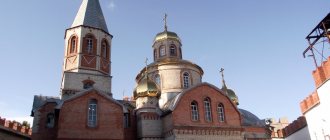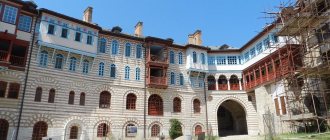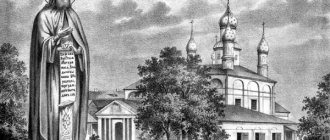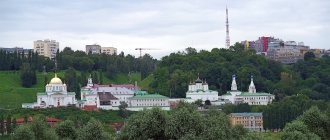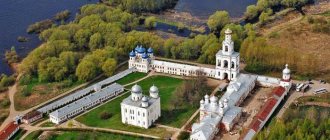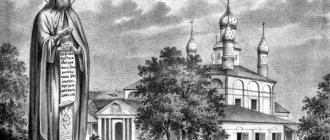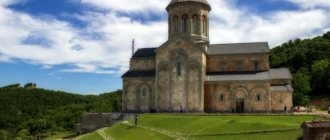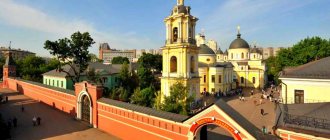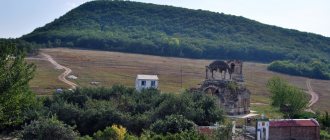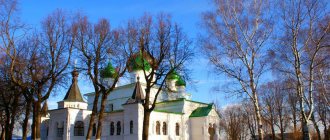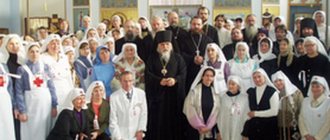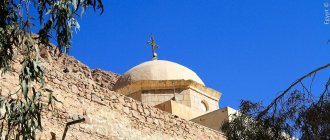| Borisoglebsky Anosino stauropegial convent | |
| A country | Russia |
| City | Moscow region, Anosino |
| Year of foundation | 1823 |
| Website | https://anosin.cerkov.ru |
| Abbot | Abbess Maria (Solodovnikova) |
The Church of Anastasia the Pattern Maker was founded by Abbess Evgeniya and named after her daughter
In the Istra district of the Moscow region there is the village of Anosino, in which the Anosinsky convent is located. Along the southern wall of the monastery there is a hospital building with the Church of St. Anastasia the Pattern Maker, founded in honor of the daughter of the first abbess of the Borisoglebsk monastery, Abbess Evgenia, Anastasia Ozerova.
Temple of Anastasia the Pattern Maker, built in honor of the daughter of the first abbess of the Boris and Gleb Monastery
The hospital building previously housed six hospital beds, cells for nuns and novices. The abbess's cell was also located here. The residential building is connected to the temple by an internal passage. In 1928, when the monastery was closed by the Soviet authorities, a collective farm club was placed in the Anastasia Church, dismantling the domed part of the building.
The current appearance of the church was restored and consecrated in 2013.
ANOSIN BORISOGLEBSKY MONASTERY
stauropegial (since December 29, 1999), in the village. Anosino, Istrinsky district, Moscow region, established in June 1823. The founder and first abbess is the abbot. Evgenia (Meshcherskaya Evdokia Nikolaevna, book., nee Tyutcheva; 02/18/1774 - 02/3/1837).
Holy gates of Anosin monastery. Photo. 2001 Holy Gates of Anosin Monastery. Photo. 2001
In 1799 in Zvenigorod district. Kng. Meshcherskaya acquired ownership c. Anosino, in May 1810, with the blessing of Metropolitan. Moscow and Kolomna Platon (Levshin) at the expense of the kingdom. Meshcherskaya founded a stone church there in the name of the Holy Trinity with 2 chapels: the Tikhvin Icon of the Mother of God and in the name of the holy princes Boris (the heavenly patron of the princess's late husband) and Gleb. When the main work on the construction and painting of the temple was completed, Anosino was plundered by the French in 1812. troops, so the consecration of the temple took place only on May 4, 1822. In 1820, the king. Meshcherskaya arranged for wives at the temple. almshouse for 11 people, in 1822 the almshouse was given the status of women. hostels in the name of the holy princes Boris and Gleb. On the same day, with the blessing of St. Philareta (Drozdova), Metropolitan. Moskovsky, book. Meshcherskaya was approved as the hostel's trustee. June 4, 1822 by Hierom. Moscow Intercession of the Most Holy. The Mother of God of the monastery, Jonah performed the first tonsure in the community of 5 sisters into the ryassophore. “Rules on the composition, dependence and structure of the highest approved Borisoglebsky hostel” were drawn up by St. Filaret. The purpose of organizing the hostel was “to provide shelter and decent maintenance... to women burdened by poverty.” Everything produced by the sisters was transferred to the “common benefit of the hostel.”
On June 25, 1823, by decree of the Holy Synod, the Borisoglebsk hostel was transformed into A. B. m., kng. Meshcherskaya was tonsured a monk with the name Evgeniy, elevated to the rank of abbess, and on September 18. took over the management of Mont-Rem. On Nov. 1823 abbot. Eugenia reported to St. Philaret that “St. gates and it would be convenient to build a small church near them in the name of St. Demetrius of Rostov to perform various services there for lay parishioners.” 12 Sep. In 1824 the temple was consecrated to St. Philaret, reconstructed in 1881. In 1828-1829. to the south In part of the monastery, a small hospital building with a shelter and a wooden (from 1854 stone) center was built. in the name of the military center Anastasia the Pattern Maker, patroness of the king's daughter. Meshcherskaya Anastasia Ozerova. In the 20s - early. 30s XIX century cells, a refectory, a workshop, grain barns, a laundry and other residential and outbuildings were built, 2 ponds were dug for fish breeding. Almost all of the first nuns of A.B. m. (12 people) came from peasant families and from serfs. Since Oct. From 1832 to 1863, the monastery, contrary to the wishes of the Anosin abbesses, was a place for repentance and correction of women convicted of drunkenness and adultery; women Old Believers were also sent to the monastery “to exhort them to return from the schism to Orthodoxy.”
With abbot. Anastasia (Komarova; 1837-1854), by decree of the Moscow Consistory, the lease of monastery lands was renewed for 20 years, and in 1842 the monastery was allocated forest lands. The cares of the abbot. Evgenia (Ozerova; 1854-1875), the granddaughter of the founder of the monastery, in 1855 a stone cell building, abbot's cells, a wooden hotel building and houses for clergy were built. Thanks to the donations of the merchant P. G. Tsurikov, a hospice house was built, and the Trinity Church was reconstructed, the Tikhvin chapel of which was reconsecrated on July 23, 1867 in honor of the Dormition of the Mother of God.
According to the inventory of 1876, under abbot. Raphael (Rovinskaya; 1875-1879) 180 nuns lived in A.B. m. Income of the monastery in the 2nd half. XIX century amounted to 5-6 thousand rubles. silver per year and consisted of donations, cash deposits, sisters’ handicrafts and income from farmland. By 1900, under the abbot. John (Makarova; 1879-1918 (1919?)), the monastery was owned by 307 dessiatines. land, including arable land - 33 dessiatinas, meadow land - 6 dessiatines, forest land - 260 dessiatines, inconvenient land - 8 dessiatines. The monastery received an annual salary from the treasury - 337 rubles. 43 k. According to the states of 1906, in addition to the abbess and treasurer, 10 nuns and 12 novices were supposed to stay in the monastery (in fact, there were 12 and 9 of them, respectively).
Anosin Borisoglebsky monastery. Photo. 2001
Anosin Borisoglebsky monastery. Photo. 2001
In the beginning. XX century A. B. m. was called “women’s Optina” and “Anosin’s desert”. Many nuns of the monastery left memories, poems, letters and other testimonies about the life of the monastery: “Conversations with my daughter” by the abbot. Evgenia (Meshcherskaya), “Memoirs” - diary and memoirs of abbots. Evgenia (Ozerova), memoirs of Schimon. Leontia (Levitskaya) and others. Although the number of nuns in the monastery was small, 11 of them were later. became abbess of other wives. Mont Rey: Rev. The Olympics are abbot. Kolomna Brusensky Monastery, Evgenia - abbot. Moscow Monastery in honor of the Ascension of the Lord, etc.
After the death of the abbot. Ioanna (Makarova) in 1918 (1919?) was appointed abbot of A.B.M. Alipiya (Taisheva). Despite heavy taxes and oppression by the authorities, the monastery did not close until 1928, becoming the largest spiritual center in the Moscow region. The monastery was visited by Sschmch. Peter (Polyansky), archbishop. Gury (Stepanov), bishop. Bartholomew (Remov), sschmch. Seraphim (Zvezdinsky), schema-higum. Tamar (Marjanova), St. Alexy (Soloviev), schema-heigum. German (Gomzin) and other devotees of the 20th century. Many nuns of the devastated monasteries moved to A.B.M., in the middle. 20s lived in Mont-re for approx. 130 sisters.
In the spring of 1928, the A.B. m. received the status of a labor artel; in July of the same year it was closed. On the basis of the monastery farm, which was considered exemplary, the collective farm “Russia” was created. All the property, archives and library of the monastery were taken to the museum of the New Jerusalem Monastery, most of the icons were burned in special tanks with acid to obtain gold. July 7, 1928 abbot. Alipia, along with 2 priests and several. she was arrested by the nuns and taken to Moscow, then sent into exile; the remaining sisters were ordered to leave the monastery within 3 days. After returning from exile, abbot. Alypia lived in Moscow for some time, then moved to the dacha of long-time benefactors of the Lobov monastery near Kubinka near Moscow, and died on March 18, 1942, taking the schema with the name Evgeniy. After the Great Patriotic War, the surviving nuns of A.B.M. were spiritually nourished by Archpriest. Sergius Orlov (later Hierom. Seraphim), rector of the Intercession Church in the village. Akulov, Mozhaisk district, Moscow region. To the beginning 90s XX century The territory of the A.B. m. was occupied by the Istra machine and tractor station, in the church of St. Dimitri Rostovsky had a cement warehouse and a collective farm club in the hospital building.
In 1992, at the request of the former. novices A. B. m. schema. Anna (Teplyakova) His Holiness Patriarch of Moscow and All Rus' Alexy II blessed the restoration of A. B. m. From Riga Sergius women. 4 nuns were sent to the monastery. On Christmas Day 1993, the first all-night vigil and liturgy were celebrated in the restored and consecrated Church of St. Demetrius of Rostov, restoration work is underway in the Trinity Church and other surviving buildings. Since 1993, the monastery had the status of a Patriarchal metochion, as determined by the Priest. Synod of December 29 1999 Patriarchal metochion in the village. Anosino has been transformed into a stauropegial female. mon-ry. In 2001, 20 sisters lived in A.B.M., the abbess was Mon. Varachiel (Buchelnikov).
Lit.: Zverinsky. T. 1. P. 101. No. 80; Denisov. pp. 518-519. No. 512; “Women’s Optina”: Materials for the chronicle of the Borisoglebsky convent. M., 1997.
E. B. Yemchenko
The first church to be built in the monastery was the Church of St. Dmitry of Rostov
At the entrance to the monastery, on the left hand is the Church of St. Dmitry of Rostov. It became the first monastery building. The church right at the gate was very convenient for parishioners, because lay people were allowed into the monastery territory only during the Liturgy.
In 1884, the temple was insulated and received a gilded cross.
After the monastery was closed and destroyed, the building was used as a store and later a warehouse.
A sign was mounted into the wall of the former church with the inscription “Mossovet Geo-office” and a number. The building was in disrepair, however, after the revival and opening of the monastery, the first divine services were held here.
After the restoration of the Trinity Cathedral, the church was closed for major repairs.
The first monastery building, Church of St. Dmitry of Rostov
On October 4, 2012, on the day of memory of the Most Holy Dmitry of Rostov, a festive Liturgy took place for the first time in the renovated church of the same name. On the eve of the opening, in 2011, the church was presented with an icon of St. Dmitry and a particle of his relics, revered shrines within the walls of the Boris and Gleb Monastery.
On March 30, 2013, the church premises were consecrated by Archbishop of Sergievo-Posad Feognost.
During the day the temple is open to parishioners, and at night Liturgies are celebrated for the sisters.
The sisters of the monastery work hard, pray, and do charity work
Today, the temple has been completely restored, services are read on all three aisles. The Church of the Holy Life-Giving Trinity was consecrated by Patriarch Kirill of Moscow in 2015.
Anosina Hermitage has one hundred and eighty nuns and novices. On the territory of the monastery there is a Sunday school, concerts and New Year trees for children are held.
The sisters visit orphanages, conduct spiritual work with convicts, receive pilgrims, and help veterans of the Great Patriotic War. The Museum of the History of the Boris and Gleb Stavropegic Monastery is preparing to open.
Tikhvin Icon of the Mother of God, one of the shrines that patronizes the Boris and Gleb Monastery
Borisoglebsky Anosin Monastery
located on Troitskaya street in the village of Anosino. This street stretches in the form of a long picturesque highway between the Istra River and the Novorizhskoye Highway, parallel to them, from the Central Ring Road to Pavlovskaya Sloboda.
Just 16 km from the monastery is Zvenigorod with the beautiful Savvino-Storozhevsky Monastery above the Moscow River, and about the same distance, but in the other, northern direction, is the city of Istra with the famous New Jerusalem Monastery.
Very close to the Anosin Monastery, closer to the Istra River, there is a modern campus of Sberbank University.
The history of the monastery began in 1810, in which Princess Evdokia Nikolaevna Meshcherskaya
, dear aunt of the poet F.I.
Tyutchev, ordered the construction of the Trinity Church. Then, at the church built at the expense of the princess, an Orthodox community was created from among her serfs. In 1820 E.N. Meshcherskaya opened an almshouse at this church. On April 17, 1823, the almshouse was reorganized into the Boriso-Gleb women's hostel
. Before this, Evdokia Nikolaevna submitted a petition to the emperor to turn the hostel into a monastery, attaching plans for existing buildings on its territory and indicating those that she was going to additionally build at her own expense.
The creation of the monastery was not an easy task, since under Empress Catherine II in the second half of the 18th century, secularization was carried out or, in other words, the alienation of church estates into state lands. The consequence of this state reform was a strong reduction in the number of monasteries and monastic people. By 1801, the number of monasteries in the Russian Empire had decreased from 1072 to 452. Borisoglebsky Anosin Monastery was the first founded in the Moscow diocese after that reform of 1783.
The Borisoglebsky Anosin Monastery was created, as mentioned above, starting in 1823 at the request of Princess Meshcherskaya, with the patronage and participation of Metropolitan Philaret of Moscow (V.M. Drozdov). He compiled the “Rules for the Borisoglebsk women’s hostel”, which formed the basis of the monastery charter.
Lay people were strictly prohibited from entering the monastery; even the closest relatives of the nuns were not made an exception. Among the first nuns and nuns of the Boris and Gleb Monastery were the serf princesses E.N. Meshcherskaya, who herself became a monk here. She became nun Evgenia, as well as the first abbess of the monastery, and remained so for 14 years until her death in 1837; she was buried in the cathedral church of the monastery. The daughter of the founder of this convent, Anastasia, also lived in the monastery, and she died early. In memory of her, the Church of St. Anastasia the Pattern Maker was built in the monastery (1827–1829).
Years later, another Evgenia (Ozerova, the granddaughter of the founder of the monastery E.N. Meshcherskaya), who ruled the monastery in 1854–1875, became the abbess of this monastery.
The fifth Mother Superior, Mother Ioanna (Makarova), headed the monastery for about forty years (1879–1919) and reposed at the age of 90 after the revolution. She came to the monastery as an 18-year-old girl.
She was a strict ascetic, did not accept any personal services, did everything in her cell herself: she cleaned, heated, set the samovar, she did not have a separate table, but used the common one, the sister’s, and, as contemporaries testified, throughout her long-term abbess she never violated this rule.
Mother attended church services indiscriminately; her last appearance in church was two days before her death. After death, a hair shirt was found on her. As an abbess, Abbess Ioanna was strict. When she accepted sisters into the monastery, she made them agree to remain in the monastery until death and did not allow any trips or vacations to their homeland. She provided care for the elderly and took every possible care so that the nuns of the monastery did not spend time idly.
At the same time, the abbess’s strictness regarding the spiritual structure of monastic life was neither callous nor cruel. She was merciful to the sisters, like a mother, and they revered their abbess. According to the testimony of Bishop Arseny (Zhadanovsky), “holy kinship” united her soul with the soul of the famous elder of the Zosima Hermitage, Schema-Abbot Herman (Gomzin), who “from time to time visited her in order to learn monasticism and console herself with conversation.”
This is the seemingly simple story of the creation of the Boris and Gleb Monastery. In fact, everything was much more complicated, sometimes tragic.
The creation of this monastery by Princess E.N. Meshcherskaya and the prelude to this are a kind of monument and glorification of courage, greatness of spirit, inexhaustible kindness and rare creative power of Russian women. The fate of E.N. Meshcherskaya is a clear confirmation of this.
In 1796, Evdokia Tyutcheva, who was then 22 years old, out of great love married Prince Boris Meshchersky. He soon caught a cold while hunting and died two months later from tuberculosis, without ever seeing the daughter whom Evdokia gave birth to a few months later.
The princess raised her daughter on her own. In 1799, she bought the small village of Anosino for her summer holiday. She built a manor house and a stone church in honor of the Life-Giving Trinity with chapels of the Tikhvin Icon of the Mother of God and Saints Boris and Gleb (in memory of her deceased spouse)!
After 1812, the estate and church had to be restored; they were completely destroyed by Napoleonic troops. This was done to the fullest extent, and they also created the Borisoglebsky Anosin Convent, which began to flourish. Despite the fact that the village of Anosino
remained small (according to the 10th revision of 1858, in the village of Borisoglebskoe-Anosino, Pavlovsk volost, Zvenigorod district, there were only 26 peasant households), the Borisoglebsky Anosin convent located there was so famous for its way of life and spiritual exploits that contemporaries called it
“women’s Optina Hermitage”
.
The foundation of the Boris and Gleb Monastery became a kind of model and example for the organization of monasteries in the new historical conditions of the 19th century. In the second half of the 19th century, following the example of the Boris and Gleb Monastery, rich women also began to create almshouses, which were then transformed into hostels - women's communities, and even later they became monasteries. It should be noted that the newly created monasteries were often headed by nuns - pupils of the Borisoglebsky Anosin Monastery.
The authority of the monastery grew year by year, pilgrims came to it, including high-ranking persons and representatives of the highest priesthood.
The great all-Russian authority of the Boris and Gleb Anosin Monastery for quite a long time helped save it from closure after the October events of 1917. It was to this monastery that Orthodox metropolitans came from exile. In 1925–1926, Archbishop Seraphim of Dmitrov lived here. In 1923, it was possible to celebrate the 100th anniversary of the founding of the monastery, then numerous guests came to it.
In 1928, the Borisoglebsky Anosin Monastery was closed. The abbess and the last six nuns were arrested, taken to Moscow, to the GPU, then they were expelled from the capital.
Soon an agricultural commune was located in the monastery, and a rural store was set up in the church in the name of St. Demetrius of Rostov. Until the 90s, car repair shops operated on the territory of the monastery.
In 1992, the monastery began to be restored. A patriarchal courtyard was opened here, which in 1999 was transformed into a monastery.
Nowadays, at the Borisoglebsk Anosin Convent, a woodworking industry has been created and a dairy farm operates. The monastery cultivates 100 hectares of agricultural land; 5 hectares of vegetable garden require a lot of attention and effort. In 2000, 30 sisters lived in the monastery and since then their number has been growing.
The former strictness of the rules of the monastery, by the way, was inherited in its new life, already in our times. At the very least, photography and video shooting are prohibited on the territory of the monastery. When we arrived at the gates of the monastery and saw with regret that it was closed to the public due to the Covid-19 epidemic, we did not immediately pay attention to the signs prohibiting photography. Fortunately, we managed to take several shots of the beautiful temples inside the monastery. We immediately received a stern reprimand and were forced to apologize for our inattention. In their defense, they said that they were not going to do anything bad, they just wanted to capture the local architectural beauty.
The monastery contains Reliquaries with particles of the relics of many saints: the patrons of the monastery, the noble prince-martyrs Boris and Gleb, Saints Demetrius of Rostov, Ignatius (Brianchaninov) and Theophan the Recluse, Spyridon of Trimifuntsky, Luke (Voino-Yasenetsky), Kiev-Pechersk ascetics, Optina elders, Saints Cyril and Mary of Radonezh, Seraphim of Sarov, Daniel of Pereyaslavl, Righteous Simeon of Verkhoturye, Blessed Matrona of Moscow, Martyr Tatiana, Martyr Eugenia, Venerable Martyrs Grand Duchess Elizabeth and Nun Varvara and other saints.
Some more interesting facts about the monastery
- In the 19th century, the Borisoglebsky Anosin Convent was a real desert: strangers were forbidden to walk on it. Hired labor was not allowed, and the nuns did everything themselves: they cooked, grew vegetables and fruits, harvested crops, even made shoes. And so that nothing would distract the sisters from prayer, there was no light in the cells (except for the lamp in front of the icons).
- In this monastery lived a nun, whose name in the world was Daria Zaitseva. In the 1930s, a 68-year-old woman was denounced: she allegedly sold holy water. He also conducts divine conversations and dislikes Soviet power. Daria was arrested and soon shot at the Butovo training ground. On March 12, 2002, she was canonized.
- In the summer of 2005, Vladimir Grigorievich Volkov, a poet, composer, author and performer of songs, settled at the Borisoglebsk Anosin Monastery. His work is military, patriotic and religious lyrics. From 1990 to 2003, Volkov held hundreds of concerts in military units, schools and hospitals, performed at charity recitals, and participated in military-patriotic events. In the same 2003, he was awarded the medal of St. Sergius of Radonezh, 1st degree. Volkov spent his last months in the Borisoglebsk Anosin Monastery: he performed obedience, caring for the garden, and wrote several new works.
This is what the poet wrote about in his poems about these places:
I would only like to go into this vastness - Into the one that is vigilantly guarding us from us.
Look, and you will meet that monastery, In which they will take pity and tonsure... *** Near the church there is a graveyard, there is my place. Having forgotten all my talents, I will avoid the bustle - and follow the path to the temple, In order to be in time for my funeral service... In November 2005, Vladimir Volkov died and was buried in a small rural cemetery not far from the monastery.
The nuns of Anosino annually attend the Irinarkhovsky religious procession
According to one of the traditions, on June 22-26, the sisters of the Anosinsky Monastery take part in the Irinarkhovsky procession.
The beginning of the procession is the Rostov Boris and Gleb Monastery in the Yaroslavl region.
The crusaders move to the holy spring and well of St. Irinarch the Recluse in the village of Kondakovo. The religious procession lasts five days. Pilgrims walk 18-20 kilometers every day, from temple to temple. They stop at each church for a prayer service and a memorial service.
At the head of the procession moves the ark with the relics of the most holy saints of God. The clergy and people walk with icons of St. Sergius of Radonezh and the patron of the religious procession, Irinarch the Recluse. They take turns carrying the heavy chains of the Monk Irinarch.
The traditional Irinarchovsky procession in honor of Sergius of Radonezh and Saint Irinarch the Recluse, in which the sisters of Anosina Hermitage also take part
Saint Philaret blesses the founder of the monastery in Anosino, Evdokia Meshcherskaya, to become abbess
In 1821, at the Church of the Life-Giving Trinity, the aunt of the Russian poet F. Tyutchev, Princess Evdokia Meshcherskaya, founded the Anosino Boris and Gleb Monastery.
Abbess Evgenia, then still Evdokia Tyutcheva, married Prince Meshchersky when she was 22 years old. Three months after his marriage, the prince died suddenly, leaving his young pregnant wife alone.
Princess Evdokia did not want to remarry, but devoted herself to raising her daughter Anastasia and charitable causes.
The photo shows a painting by the artist Spazhinsky, which depicts Princess Meshcherskaya with her daughter and pupil. The painting is still kept in the Muranovo estate and bears marks from saber strikes.
In 1799, she acquired the village of Anosino on the banks of the Istra River, where she subsequently built a church in honor of the Life-Giving Trinity, with chapels of the icon of the Mother of God of Tikhvin and saints Boris and Gleb, in memory of her deceased husband.
At the church, in 1821, an almshouse was opened, which was later transformed into a convent. The charter for the monastery was personally drawn up by Saint Philaret.
Story
The Borisoglebsk convent, located in the village of Anosovo, Istrinsky district, has an interesting history, in which there were both joyful and sad pages. All of them strengthened the Faith and Spirit of the nuns.
Base
The history of the Borisoglebsk monastery began in 1799, when Princess Evdokia Nikolaevna Meshcherskaya (nee Tyutcheva) bought the village of Anosovo, located in a beautiful area on the banks of the Istra River. In 1810, the widow of Prince Boris Meshchersky received the blessing of Metropolitan Platon of Moscow to build a temple in her domain in the name of the Life-Giving Trinity. In memory of the late spouse, the northern aisle of the church was consecrated in honor of the holy passion-bearers Boris and Gleb.
Borisoglebsky Anosin stauropegial convent
In 1820, an almshouse was organized at the Trinity Church, in which 11 women lived. After 2 years, the almshouse was converted into a women's hostel in honor of Saints Boris and Gleb. With the blessing of Saint Philaret, Princess Meshcherskaya became her guardian. A year later, the monastic community received the status of a monastery, and its guardian was tonsured a nun under the name Eugene and elevated to the rank of abbess of the monastery she organized.
Her spiritual mentor was Saint Philaret, who drew up a strict Ionic rule for the community, characteristic of the desert.
The following rules were established:
- strangers had no right to move into the territory of the monastery;
- nuns were forbidden to leave the monastery or visit relatives;
- almsgiving was prohibited;
- nuns should spend time in work and prayer, which began at night;
- nuns had a minimum set of necessary things, without the right to accept anything from the world.
Abbess Eugenia managed the created monastery until 1937. In February of this year, her earthly journey ended. The founder of the monastery was buried at the northern aisle of the Trinity Church. During her management, the main architectural appearance of the monastery territory was formed. The following buildings were erected:
- the monastery fence with the holy gates and the chapel of St. Dmitry of Rostov;
- hospital building;
- Church in the name of Anastasia the Pattern Maker;
- stone cells;
- refectory;
- granary for storing bread;
- workshop building.
In addition to the construction of residential and utility buildings, a garden and 2 ponds for fish breeding were built on the territory of the monastery.
Interesting: under Abbess Evgenia, women who abused alcohol, adulteresses, and female Old Believers began to be sent to the Anosinsk monastic community for repentance and correction. This practice was carried out against the wishes of the abbess.
Heyday
The monastery reached its greatest prosperity in the second half of the 19th century. Under the granddaughter of the founder of the monastic community, who also received the name Eugene when she was tonsured, the construction of new buildings and the reconstruction of existing buildings continued. The monastery, located on a small territory, was an example of a communal desert, the nuns of which became famous throughout the country for their spiritual exploits. They became abbess of women's monasteries throughout the country.
Trinity Cathedral of Anosin Boris and Gleb Monastery
Many pilgrims came to the Moscow courtyard of the Borisoglebsky Anosin Monastery. The highest ranks of the Moscow diocese often came to the hermitage near Moscow, for whose residence a special building was built.
In addition to spiritual exploits, the nuns were famous for their economic activities. Successful experience in agriculture, animal husbandry and crafts was adopted by laymen and monks from all over the empire.
After the Bolsheviks seized power, the monastery solemnly celebrated its centennial anniversary.
Decline and destruction
The Borisoglebsky Anosin Monastery officially existed until 1928. The life of its nuns at that time changed significantly. The nuns, subject to high taxes, had to expand their farms and produce products for sale. Difficult living conditions strengthened the sisters’ humility and fortitude. At the time of closure, 130 nuns lived in the monastery.
In the summer of 1928, Abbess Alipia and several nuns were arrested and then sent to labor camps. The remaining nuns were kicked out of the monastery. They dispersed to different parts of the country, but continued to keep in touch and help each other. An agricultural commune was organized on the territory of the monastery, which existed until the monastery’s food supplies ran out.
Material assets and shrines collected in the temple were destroyed. Valuable utensils were confiscated back in 1922 under the pretext of helping the starving. Holy images in precious frames were immersed in acid, separating the gold. The monastery bells were melted down for household needs.
Hospital with the Church of Anastasia Anosin of the Boris and Gleb Monastery
A club was organized in the Church of St. Anastasia, which was later converted into a residential barracks. A village store was located in the Dmitrovsky Church. Part of the Trinity Cathedral was destroyed during the Great Patriotic War. In the surviving part until the 90s. last century there was a repair shop for agricultural machinery.
Renaissance
By 1992, of the former nuns, only schemanun Anna was alive. She turned to His Holiness the Patriarch with a request to help restore the monastery. Until 1999, the monastery territory had the status of a patriarchal metochion. In the last days of the 20th century, the courtyard in Anosino was given the status of a stauropegic monastery.
The first nuns of the revived monastery were the nuns of the Trinity Monastery, founded in Riga by nun Sergia (Mansurova), who is the spiritual daughter of the Anosinsk abbess Evgenia (Ozerova). In 2005, nun Maria (Solodovnikova) became abbess.
The Anosinsky Boris and Gleb Monastery had a strict charter that taught the sisters to humility and monasticism
Having wished to become a monk, Evdokia Meshcherskaya petitioned to join the hostel. According to the instructions of Saint Philaret, she accepted the abbess. So, in 1823, the Anosinsky Monastery found its first abbess, Abbess Evgenia.
At the age of 63, Mother Eugenia died and was buried in the monastery Trinity Church, near the chapel of the holy princes Boris and Gleb.
Mother Evgenia kept the nuns strictly.
According to the charter, they had no right to leave the monastery either to collect donations or to visit relatives.
They did all the work to support the monastery themselves, from sewing shoes to chopping wood and preparing food for meals.
So that nothing would distract the sisters, they had only the most necessary things in their cells. There was no lighting in the room except for a small lamp near the icons.
The charter taught the nuns to humility and monasticism. Mother was no exception, praying for many hours both in church and in her cell.
The patriarchal service on the eve of Holy Week is proclaimed by Metropolitan Kirill of Moscow and All Rus' within the walls of the Anosino Stavropegic Monastery.
Convent and Princess Abbess
A church was built in memory of his wife in Anosino, but the cherished desire of the widow of Prince Boris Meshchersky was to found a monastery. Having married her daughter Anastasia, Evdokia Meshcherskaya founded a hostel at the church in 1820. It was not yet a monastery, but an almshouse in which 12 women lived. Three years later, the women's dormitory received the status of a monastery, and Princess Meshcherskaya herself became a monk with the new name Eugene. By decision of the hierarchs, the founder of the monastery near the Istra River became the first abbess.
After the establishment of the monastery in Anosino, the princess abbess built two more small churches. This was the temple of St. Dmitry of Rostov and the church at the monastery hospital of the Great Martyr Anastasia the Pattern Maker. The monastery buildings belong to the Empire style. It spread in Russian architecture after the victorious end of the war with Napoleon. Trinity Church has some features of the Baroque style. For example, the dome of the main Trinity Church is decorated with lucarnes. These are windows protruding forward from the dome. A similar type of dome with lucarnes can also be seen at the St. Nicholas Church in Zayaitsky in Moscow.
Abbess Evgenia led the Anosin Monastery for 14 years. In 1837 she died and was buried on the north side of the cathedral near the chapel of Boris and Gleb. Later, the granddaughter of Princess Evdokia Ozerova became a nun at the Anosin monastery. As a monk, she also received the name Eugene, becoming her grandmother’s successor in everything. Evgenia Ozerova led the monastery for 20 years. Her grave is also located next to the chapel of Saints Boris and Gleb.
